Runway Archive: Valentino, Ready-to-Wear Winter 1979-1980

The image captures a moment of fun on the runway of the Valentino winter 1979-1980 collection. The models are wearing two total-black outfits, composed by an two different ‘little black dresses’, one made of velvet and the other probably of sheer silk, and pointed heels. The two outfit are completed by flamboyant hats and accessories.
The picture shows the two models dancing together: an interesting way to interpret the usual walk down the runway. The freedom and joy the image evokes might seem in contrast with the rather repetitive and rigorous parades at fashion shows. This has probably to do with the fact that the image comes from the show of a ready to wear collection: a different, more accessible line designed by Valentino, quite different from the couture. Through this line, the designer updated his definition of fashion, speaking to a wider audience and proposing another side of his personality to his public.
‘Margiela: The Hermès Years’ on Europeana Fashion Tumblr

This April, MoMu – Fashion Museum Antwerp curates the Europeana Fashion Fashion Tumblr with the images of its current exhibition ‘Margiela: The Hermès Years’.
From 1997 to 2003, fashion designer Martin Margiela, founder of the Maison Martin Margiela, has been the creative director of Hermès. These six years are narrated by MoMu – Fashion Museum Antwerp on our the Europeana Fashion Tumblr, in concurrence with the museum’s exhibition.
The curation features exclusive images illustrating the themes and the objects on display in the exhibition; alongside the pictures of the actual pieces, the curation includes selected photographs of the works of Martin Margiela for both his own Maison and for Hermès, to draw comparison and understand how these two brands influenced and quoted themselves, while designed by the same person.

Maison Martin Margiela A/W 1996-1997, Photo: Anders Erdström. Hermès A/W 1998-1999, Photo: Studio des Fleurs. ‘Margiela, The Hermès Years’, 31st March - 27th August 2017. Image courtesy MoMu - Fashion Museum Antwerp.
The exhibition displays in particular the connections through a selection of garments and accessories. the objects are put in dialogue in sections individuating the main themes and elements introduced and developed by Martin Margiela in his design practice, and how he declined them in his work.
For more information about ‘Margiela: The Hermès Years’, on show through the 27th August 2017, please visit MoMu’s website. Check out the Europeana Fashion Tumblr everyday not to miss a post!
THE EDITOR’S COLUMN: AUTHORSHIP
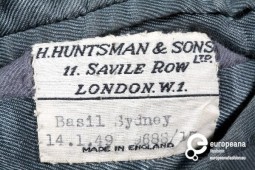
In fashion, names are crucial: the history of fashion was constructed on the names of the designers who shaped the most iconic silhouettes, or designed the unforgettable items that became symbols of their time. However, this kind of history is guilty of leaving behind some of the names whose role is not so visible, but still of invaluable importance.
Fashion objects themselves can be used to challenge this narrative, allowing us to discover new stories hidden behind the scenes of their production. What we consider fashion objects, be it clothes or accessories, are the end result of a process that involves many different actors. They originate from the encounter of different realities, sharing knowledge and abilities in order to produce something.
The visibility designers have nowadays turned them into public personae, whose image and name is directly linked to the aesthetic they develop in their work. The status of celebrities granted to designers has a flip side: it often ends up concealing the intricate network of artisans, technicians, manufacturers, producers without whom fashion could simply not be possible.
Fashion objects and their biographies can be used as tools to question the common definition of author, and make us rethink creation in terms of lively networks. The stories of the production of fashion items are interesting because they make us understand that every detail of an object comes out of a dialogue, a collaboration, a partnership.
Fashion materially explains that creativity has to be paired with technical rigour, savoir faire and craftsmanship. By choosing authorship as this month’s theme, we want to present some of the ways in which designers have constructed their image and exploited their visibility in order to make some statements through fashion. We also intend to look at the experiences and personal relationships behind the creation of beautiful objects.
Europeana Fashion Focus: Hat designed by Max Heymans, 1950s.
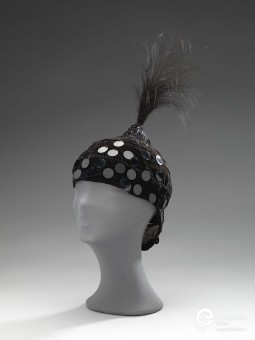
The picture shows a cocktail hat designed in the 1950s by Max Heymans, dubbed the ‘godfather’ of Dutch couture.
The hat is helmet shaped with no brims, and the back is longer that the front. It is made of velvet, and from the ornate top appears a tuft of black egret feathers. The hat is decorated with large sequins that don’t cover the hat with a regular pattern. The inside is unfinished, with no linings.
Dutch couturier Max Heymans has designed hats throughout all his life. First, for his mother when he was young and later for his clients. Although he was helped by milliners such as Suzanne Moulijn to realise his creations, his obsession had him developing his first silhouettes to accompany his headwear. Although still influenced by Parisian fashion, his collections reflected his own personal vision, darkened by the events of the Second World War. His fruitful career lasted from 1945 to 1997.
Runway Archive: Vivienne Westwood, Pitti Uomo 38, 1990
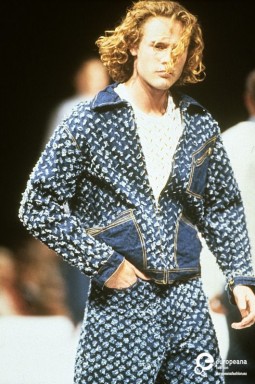
The image shows an outfit designed by Vivienne Westwood for her s/s 1991 collection shown at Pitti Uomo 38. The model wears a white shirt in a loosely weaved fabric under a denim oversized jacket, whose proportions and lines remind of a sixteenth century doublet. In particular, its punched texture recalls the one worn by the Tailor in the infamous painting by Giovan Battista Moroni.
The British fashion designer Vivienne Westwood is known for her use of the past to find inspiration for her collections. Her own version of nineteenth century Victorian figures or Parisian cocottes are considered a milestone of fashion history. Although her vision is romantic, however, the designer’s practice is very much merged in the present. her revoluntary activities and ideas allow her to use fashion as a way to raise awareness on topical issues of contemporary times.
Bruno Pieters: Time Conscious
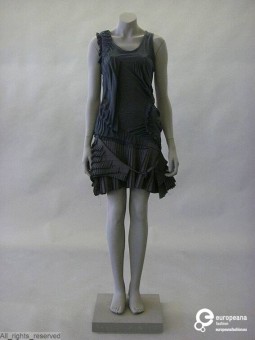
The influence of time over fashion also concerns its production; even if from a mere economical point of view, time has a big impact on the production costs and the final price of a garment.
In this sense, time is such a topical theme today that brand’s focus over faster or slower production techniques can determine the very identity of a brand. Being conscious of time and its value is an important quality for designers, not only for the definition of their aesthetics but also for shaping their approach towards the production and commercialisation of their clothes.

'Delyth', dress designedby Bruno Pieters, 2004. Courtesy MoMu - Modemuseum Provincie Antwerpen, all rights reserved.
From June to July 2016, Antwerp hosted the exhibition ‘Beyond the Clothes’, curated by Bruno Pieters. The exhibition displayed the ways the Belgian fashion designer approached these issues with his own project and website, Honest By. Bruno Pieters. This project, launched in 2012, aimed at stimulating costumers’ consciousness over themes such as sustainability and transparency.

'Tatja', dress designedby Bruno Pieters, 2005-06. Courtesy MoMu - Modemuseum Provincie Antwerpen, all rights reserved.
Bruno Pieters, who graduated from the Royal Academie in Antwerp in 1999 and gained experience at Christin Lacroix, Maison Martin Margiela and Josephus Timister, first started with his website, which he created after a two years long hiatus. In it, for each piece on sale, he described in details the manufacturing process and the information of the materials and accessories.
These details serve not only to retrace the story of the garment back from its conception but also to keep trace of operation and works that, beyond the clothes, usually remain invisible or untold. What lies beyond clothes, in fact, is the craftmanship of a group of authors and interpreters that convey their knowledge and experience to the realization of the product. Therefore time acquires a great importance as it is the direct expression of their contribution abd one of the key terms to value it. At a time when fashion and its industry speed up their pace to the extreme, the consciousness of the time needed and its costs are essential to understand, and maybe defend, the right to take it.
Temporal Meditations: Hussein Chalayan at Pitti Immagine 64

For the 64th edition of Pitti Immagine Uomo, Hussein Chalayan showed his first men’s collection, developed in collaboration with Pitti Immagine. The designer decided to mark his debut in menswear presenting Temporal Meditation, the first movie he wrote and directed.
The movie premiered on 19th June 2003 at Teatro della Pergola in Florence. It was shot in Athens, and saw as protagonists the photographer Mark Segal and Sophie Hill, a Greek actress. Even though it was the first time that Chalayan presented himself as film director, he was not new to experimentations that could combine fashion and art. He was well known for blending art and fashion in his own practice, working both within the fashion system and in art galleries.
The movie is 20-minute long; the action takes place in an airport, a liminal non-place where the boundaries between different countries seems to be negates, and time suspended. the narrative is constructed by many themes: identity, memory, time. Chalayan used genetic anthropology to draw the ethnic paths that crossed Cyprus, his homeland, within space and time. This interest in human geography and migration is very dear to the designer, who constantly refers back to the idea of ‘homeland’ as constant reference characterising his fashion and artistic production.
The press release of the event states: “Historical discourse has exemplified a view of time as sequential and progressive which has been embalmed through the use of the printed word. Garments can be viewed as an archaeological talisman which morphs slivers of past and present, ultimately and perhaps paradoxically becoming a frozen fragment of its own archaeological quest”.
The movie proposes to consider clothes as symbols holding together different chronological dimensions; In their being material memories of an undefined past that still bear sign of the present, they become traces that have to be rediscovered through quasi-archaeological techniques in order to reveal their meaning. This way, clothes have the power to negate the linearity of the time of history proposing instead a chronology dictated by feelings, memories and emotions.
Runway Archive: Lapidus, Autumn-Winter 1996, Couture
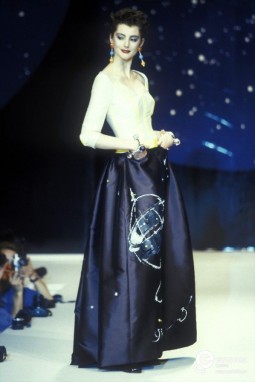
The picture shows a model wearing a full, long, taffeta skirt and a long-sleeved white top with deep square neckline. A globe is printed on the front right of the skirt. The model, also wearing a pair of long and colourful earrings, is posing for the photographers, with her hands in the small pockets of the skirt. The look belongs to the A/W 1996 Couture collection of Lapidus.
Edmond “Ted” Lapidus was a French fashion designer. After an apprenticeship with Dior, Lapidus founded his fashion house in 1951, gaining popularity during the 1960s and 1970s. In 1989 Ted Lapidus’s son Oliver Lapidus took over the label. In 2000 Lapidus stopped the couture line, and since then the label produces fashion accessories like watches and fragrances.
Exhibition Archaeology: Spectres. When Fashion Turns Back
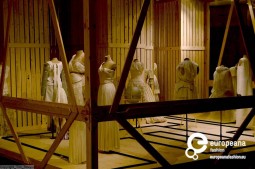
Fashion spans many temporalities. While being projected to the future, it constantly looks back to the past to which it strongly relates. As explained by Walter Benjamin with the image of the ‘tiger’s leap’, fashion interacts with history in many and different ways. Back in 2004, curator and exhibition maker Judith Clark explored this haunting relationship in the exhibition ‘Spectres. When Fashion Turns Back’.

The exhibition 'Malign Museus. When Fashion Turns Back' at MoMu - Fashion Museum of the Province of Antwerp, photo by Tim Stoops, 2004. Courtesy MoMu - Modemuseum Provincie Antwerpen, all rights reserved.
The exhibition was first installed at MoMu, in Antwerp, from September 2004 to January 2005 with the title ‘Malign Muses. When Fashion Turns Back’ and later at the Victoria and Albert Museum in London, from February to May 2005. As explained in the catalogue of the exhibition, it took shape after a two years long conversation between Clark and the fashion theorist Caroline Evans, author of the seminal text ‘Fashion at the Edge’, whose suggestion and ideas served as an inspiration for the real-life devices that characterised the set of the exhibition.
The display recalled the dark atmosphere of the Victorian circuses and freak shows; it used devices such as toys, carousels and lantern slides tricks to evocate the ghastly bound between fashion and history and to articulate the complicate and introspective sections of the exhibition, in which the creations of contemporary designers where shown alongside historical pieces in suggestive juxtapositions.

The exhibition 'Malign Museus. When Fashion Turns Back' at MoMu - Fashion Museum of the Province of Antwerp, photo by Tim Stoops, 2004. Courtesy MoMu - Modemuseum Provincie Antwerpen, all rights reserved.
The sections of the exhibition were: ‘Reappearances: Getting Things Back’, ‘Nostalgia’, ‘Locking In and Out’, ‘Phantasmagoria: The Amazing Lost and Found’, ‘Remixing It: The Past in Pieces’, ‘A New Distress’ and, in Antwerp, ‘The Garden of Forking Paths’. They explored the modalities through which fashion turns to the past through the results of these various operations. If history serves as a source of inspiration, it also represents a bound to be broken or ignored to move forward, an instrument at the designers’ disposal for the invention of new stories with clothes.

The exhibition 'Malign Museus. When Fashion Turns Back' at MoMu - Fashion Museum of the Province of Antwerp, photo by Tim Stoops, 2004. Courtesy MoMu - Modemuseum Provincie Antwerpen, all rights reserved.
Contemporary designers, such as Junya Watanabe, Dries van Noten, Viktor and Rolf, Simon Thorogood, Hussein Chalayan, Shelley Fox and Rei Kawakbo, featured in the exhibition; their creations were put in dialogue with those of earlier couturiers, such as Schiaparelli, Madame Grés, Jean Dessès and Dior, and previous century costumes, to highlight the references and similarities: all the elements contributing to a discourse that draws back and puts forward the figures inhabiting past and present, to tell new, compelling stories.
“Gianfranco Ferré. Moda, un racconto nei disegni”: Exhibiting the Process and Poetic of Fashion Design
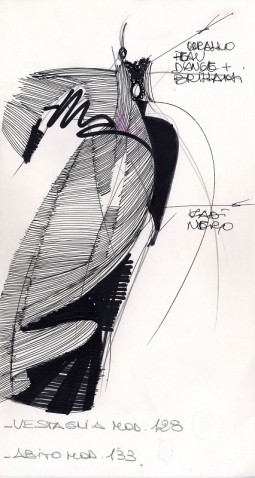
From the 21st April, Centro Culturale Santa Maria della Pietà in Cremona, Italy, will host ‘Gianfranco Ferré. Moda, un racconto nei disegni’, an exhibition dedicated to the sketches and drawings by Italian fashion designer Gianfranco Ferré.

Silk taffeta and silk velvet cape with topstitching. Silk velvet dress. Alta Moda, Fall/Winter 1988. Pencil, fine black felt-tip pen, colored felt-tip pen on construction paper. Courtesy Fondazione Gianfranco Ferré, all rights reserved.
An architect by formation, Gianfranco Ferré has been one of the greatest name of Italian fashion. With his sapient use of sartorial construction, materials and decoration, he introduced a new sensibility in fashion, frequently represented by his iconic creations.

Silk grisaille trench coat. Prêt-à-Porter, Spring/Summer 1988. Pencil, fine black felt-tip pen, colored felt-tip pen on construction paper. Courtesy Fondazione Gianfranco Ferré, all rights reserved.
The exhibition ‘Gianfranco Ferré. Moda, un racconto nei disegni’ is curated by Rita Airaghi, Director of the Fondazione Gianfranco Ferré, and was developed with the collaboration of the Municipality of Cremona. While including some of the garments he designed, it will focus on his hand-signed sketches and drawings, one of the most fascinating artefacts of the designer’s creative process. Quoting Gianfranco Ferré himself: “For me drawing means jotting down on paper a spontaneous idea which I can then analyse, check, verify and finetune, reducing the basics to precise concise lines set on diagonals and parallels within geometric shapes and figures… as both a fashion designer and an architect I see fashion as a form of design…”; either elaborate and detailed or more essential and instinctual, the selection of over one hundred sketches on show in Cremona tells the history of the vision, passions and ideals of the poetic fashion creator, as well as unveiling to the public a part of his unique creative process.

Printed silk and lurex caftan with embroideries and sequin appliqués. Prêt-à-porter, Spring/Summer 1990. Pencil, fine black felt-tip pen, pastel crayon, gold powder on construction paper. Courtesy Fondazione Gianfranco Ferré, all rights reserved.
While fixing on paper the necessary information to turn the fashion designer’s ideas into material creations, these drawings are also greatly evocative artworks; they show the idea of beauty, harmony and style that the designer developed and improved during his prolific career both at his own brand and as the creative director of the Maison Christian Dior, where he worked from 1989 to 1997. More than instruments, these drawings are a statement of Gianfranco Ferré dedication to fashion design, an important working method and an indispensable key to comprehend the work of Gianfranco Ferré both in its materiality and his aesthetics.
The exhibition will be open until the 18th June.









